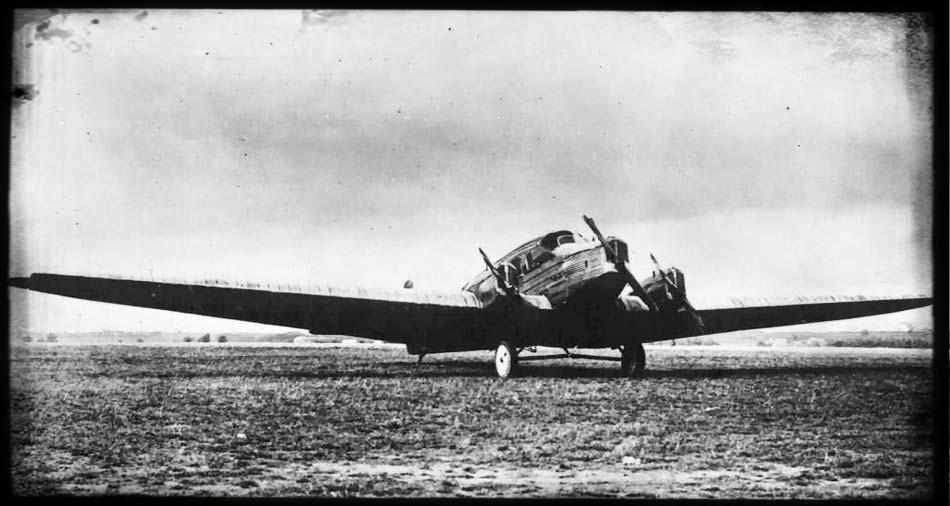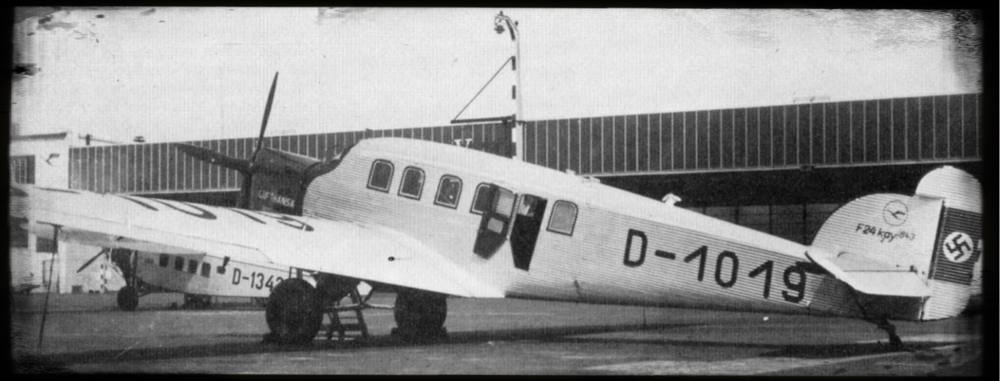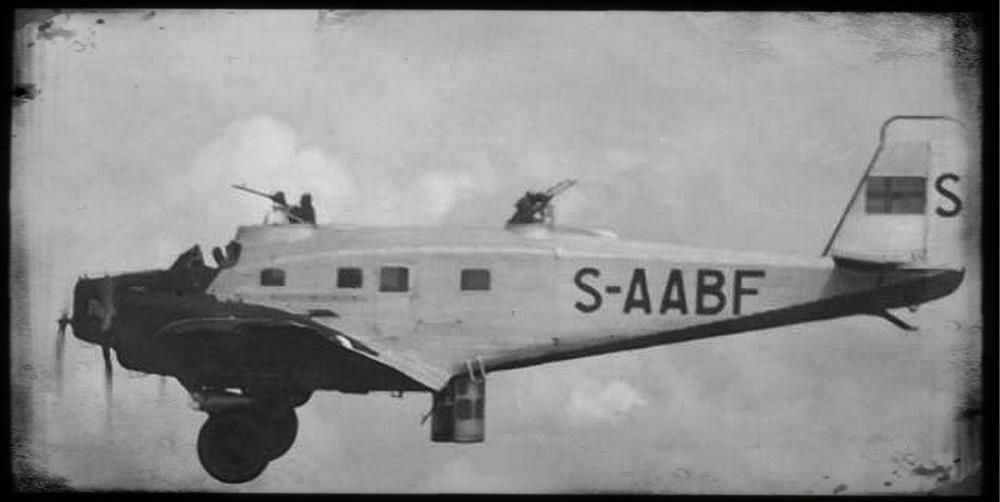Junkers G23 and G24
see also: Junkers G23/G24 Production List / Junkers G23/G24 Philatelic Items / Junkers G23/G24 Model Kits
Ten seater cantilever monoplane passenger aircraft , F/F 18 Sep1924, about 80 built
developed by Junkers Flugzeugwerke in Dessau

Junkers G23 Prototype
Historical Background:
During the first half of the twenties the German air transport market showed a continous increasing demand. The Junkers F13 just offered seats for a maximum of 4-5 passengers. This quickly became not enough for the major routes in Germany and Europe. In 1923 Junkers advised Zindel to think about a larger version of the F13. Like the F13, Zindel initially designed a single engined enlarged version of the F13. But due to the lack of powerfull engines in Germany in 1923, Zindel had to review the design. Instead of a single engine, the G23 got three Junkers L2 engines with 145 kW each.
But the ILUK (International Aviation Control Commission in Germany) stopped the design again due to the powerfull engines and ranked the G23 as a military aircraft. Finally the G23 got two Mercedes D I engines and one BMW IIIa center engine. The final assembly of the G23 was performed at Nuremberg Fuerth airport as the Dessau facilities became to small for F13 production and G23 developement. The first G23 (c/n 831) was performed on 18th September 1924 at Fuerth by Wilhelm Zimmermann but during the landing the aircraft crashed. 
Early G24ge of 1926 with three Junkers L2 engines
The G24 was the more powerfull version of the G23 and a parallel unofficial development. ILUK banned this more powerfull aircraft. Therefore at Dessau all aircraft were built according to the legal G23 standard. But those Dessau built aircraft were then transfered to A.B. Flygindustri at Limhamn in Sweden and were equipped with the more powerfull Junkers L2 engines there according to the G24 standard. Most of this Limhamn modifications returned to Germany and were used by German airlines under the designator G23. The G23/G24 was built between 1925 and 1929 and a lot of different engine versions became available during that time. It became the backbone of the German air transport industry during the second half of the twenties.
To prevent the production line of the G24 from interventions by the ILUK, only the initial G23 aircraft with the less pwoerfull engines were produced at Dessau. Later Dessau only produced the parts for the G24s, which were transfered to Limhamn, where they were mounted as A.B. Flygindustri aircraft. Finally since 1926 the complete G24 production was returned to Dessau, after the Allied restrictions were lowered. A total of about 20 G24s were produced at Limhamn. 
Junkers F24
The G23/G24 was originally designed by Zindel as a single-engined aircraft. But due to the missing engines, which offer enough power for the aircraft, Zindel had to design a three-engine aircraft. During the second half of the 20s more powerfull engines became available, like the BMW VI. Luft Hansa, who operated the largest G24 fleet in the world, decided to modify their G24s to a single engine standard. First modifications were performed in March 1928 at the Luft Hansa technic base at Berlin-Staaken. The wing of the G24 was shortened by the parts of the engine mountings and the center engine was replaced with a BMW VIU engine. According to the Junkers designator scheme, this aircraft was designated F24ko. A total of 11 G24s were modified to F24 standard between 1928 and 1930. By July 1933 most of these BMW-equipped F24s were again modified with the new Jumo 4 and designated as F24kay. Already in 1931 a Junkers F24 was equipped with this new engine as a testbed. Most of these F24 remained in service until the beginning of WWII in 1939. Most of them were used as freighter aircraft by Lufthansa. 
Junkers / AB Flygindustri K30
One of the demands of the Soviet forces for the joint venture of Junkers at Fili was the developement of bomber aircraft. To fullfill this demands, Junkers designed the Junkers Ju25 as a twin engined bomber aircraft. But the developement of this aircraft was to expensive for Junkers, especially regarding the outcoming difficulties with his Russian partners. Therefore Junkers advised Zindel and Pohlmann to design a military derivate of the G24. In November 1924 an initial design was finished under the designator G3S1 24. This initial design was declared as an ambulance aircraft and was directly taken from the G24ba. This design was followed by several reconaissance designs G1Sa 24 which taken from the G24 design, but which were single engined. The next design G2sB 24 was again three-engined and became a bomber aircraft, which was directly derivated from the G24he again. This design got a new center wing section and a new nose section, for getting a free shooting area to the forward areas. Junkers decided to produce this design as a general military version of the G24 under the Junkers designator K30 in 1926. Junkers offered the K30 design to the Russian forces, which ordered a total of 23 K30 aircraft in 1925 and 1926. As the German aviation industry was still not allowed to built military aircraft in 1926, again the production line for these military K30 was set up at A.B. Flygindustri at Limhamn in Sweden. The parts for these K30 aircraft were built at Dessau and then shipped to Limhamn, where A.B. Flygindustri built the K30 under the designator R42. Some of the R42 were already equipped with machine gun towers and bomb mountings. But several of the R42 were also shipped without military equipement to Russia. Those aircraft were military equipped at Fili. In Russia the R42/K30 was designated as JuG-1. Six more R42s were delivered to Chile during 1926 plus three K30 to Spain and two K30 to Yugoslavia until 1931. The Spanish and Yugoslavian aircraft were produced at Dessau. The K30 was equipped with wheels, skies and swimmers. Following the successfull conversion of the G24s to a single engined aircraft F24, Junkers was also thinking about a single engined K30 in 1931. Like the F24, this K30do should be equipped with the Jumo 4 and was similar to the initial G1Sa 24. But none of this single engined K30s were built.
Record flights of the G24:
01.05.1926 Inaugeration of Passenger Night flights
Luft Hansa started first night operational flights from Berlin to Konigsberg with passengers.
24.07.1926 Peking expedition flight
On July, 24th 1926 a Luft Hansa expedition flight over 20000km
from Berlin to Peking started with 2 G24 aircraft, D-901 and D-903
04.10.1927 South Atlantic expedition flight
A G24h1e of Severa took off from Norderney to Acores
from where it should cross the South Atlantic.
But the operation had to be dropped due to a crash at the Acores.
28.06.1927 Speed Record
On June, 28th 1927 Junkers pilot Zimmermann achieved the speed record
for 1000kg payload with 209,115km/h
01.04.1927 Distance Record 2000kg payload
On April, 1st 1927 Waldemar Roeder achieved a new distance record with a G24L
for 2000kg payload with 1013,18km in 7 hours and 52 minutes.
04.04.1927 Distance Record 1000kg payload
On April, 4th 1927 Fritz Horn achieved a new distance record with a G24L
for 1000kg payload with 2026,36km in 14 hours and 23 minutes.
10.04.1927 Speed Record 2000kg payload over 500km
On April, 10th 1927 Hermann Roeder achieved a new speed record with a G24L
with 2000kg payload over 500km with 175,75km/h.
During the same flight the record for 2000kg over 100km was achieved with 179,24km/h
01.06.1927 Speed Record with 2000kg payload over 100km
On June, 1st 1927 Zimmermann achieved a new speed record with a G24L
for 2000kg payload over 100 km with 207,26km/h.
The record flight was performed between turning points at Dessau and Leipzig.
23.06.1928 Afghanistan expedition flight
On June, 24th 1928 one G24 and two F13 aircrafts started for an Afghanistan expedition flight
06.08.1927 K30 performed FAI World Record Flights
On August 8th 1927 a K30 seaplane performed a World Record Flight. Over distance of 1000 km and with a payload of 1000 kg, the K30 reached a speed of 171 km/h. The flight time of 10 hrs. 42 min. 45 dec. was also a FAI Record, as well as the flight distance of 1176 km.
Aircraft G23 1924 1 BMWIIIa + 2 Benz DI 15,25 28,50 89,00 3600 2400 2 pilots+ 175 1000 G3 S1 24 1924 3 x Junkers L2 15,25 28,50 89,00 T/O 5500 1 pilot+ n/a n/a
year engine length
in mspan
in mwing area
im sqmnet weight
in kgpayload
in kgseats speed
in km/hrange
in km
G24
G24ba
G24bi
G24ce, de, fe
G24ge
G24gn
G24he
G24hu
G24li
G24mai
G24nao
G24L
F24ko
F24kae
F24kai
F24kau
F24kay
1924
1925
1926
1927
1929
1929
1930
1929
1928
1936
n.a.
1929
1 x L2 + 2 DIIIa
3 x L2
1 x L5 + 2 x L2
3 x L5 (228kW)
3 x L5 (228kW)
1 x L5 (310kW), 2 x L5 (228kW)
3 x L5 (228kW)
3 x BMW Va (265kW)
1 x L5, 2 x L2
1 x Frachini 368kW, 2 x L5
3 x Jupiter (375kW)
3 x L5G (312kW)
1 x BMW VIu (470kW)
DB600
Jumo 211
BMW VIIaU (510kW)
Jumo 4 (529kW)
15,25
15,25
15,25
n.a.
15,80
15,80
15,25
15,70
15,25
15,25
n.a.
15,25
15,25
28,50
28,50
28,50
29,80
29,80
29,80
29,37
29,37
28,50
29,80
28,50
25,90
n.a.
25,90
25,90
89,00
89,00
89,00
94,60
94,60
94,60
89,00
89,00
89,00
94,60
89,00
79,20
n.a.
79,20
79,20
3700
3800
4000
4300
4500
4330
4500
4000
n.a.
4700
3410
n.a.
3810
1800
2200
2300
2000
2000
2870
2700
2300
n.a.
1800
1190
n.a.
1190
9 pass.
G24he
14 pass.
F24
6 pass.
175
185
210
210
210
220
185
>n.a.
210
200
n.a.
195
1050
n.a.
n.a.
1290
n.a.
n.a.
680
660
n.a.
580
G1 Sa 24
G2 Sb 24a
G2 Sb 24b
G2 Sb 24c
K30
K30do
1924
1924
1924
1924
1926
1931
1 x 588kW
3 x Junkers L2 (184kW)
3 x Junkers L5 (220kW)
1 Napier L, 2 x Junkers L5
3 x Junkers L5 (220kW)
1 x Jumo 4 (550kW)
15,50
15,25
15,25
15,25
15,30
15,25
25,90
28,45
28,45
28,45
29,50
28,45
79,00
83,00
83,00
83,00
94,60
83,00
3000
3400
3500
3650
3784
n/a
1700
2220
2500
2350
2446
n/a
4
190
180
190
200
175
n/a
1160
900
900
1050
1000
n/a
G23/G24 Designators:
- G23, design designator for prototype with 1 BMW IIIa and 2 Mercedes D1 in 1924
- G24, improved version with 1 Junkers L2 and 2 Mercedes DIIIa engines in 1925
- G24a with three Junkers L2 engines, attachment on wings, smaller engine cowlings
- G24ba with three Junkers L2, strengthened attachements and engine mountings
- G24b1a seaplane version of the G24ba for Aero O/Y
- G24bi with one Junkers L5 center engine and two L2 engines
- G24ce with three Junkers L5, enlarged wing attachement since 1926
- G24e with three Junkers L5
- G24de strengthened attachements, smaller engine cowlings
- G24fe enlarged center wing attachements
- G24ge further enlarged wing attachements
- G24g1e seaplane version of G24ge, used for torpedo experiments
- G24gn Junkers L5 center engine with 310kW, one built
- G24he with modified wing, seperate undercarraige, aerodynamic cockpit, 14 passengers
- G24h1e seaplane version of G24he
- G24hu with three BMW Va, one built
- G24li modified G24a/b with Junkers L5 center engine
- G24mai modified G24e with Isotta Frachini center engine for Italy
- G24nao with three Rhone Jupiter engines, K30 prototype
- G24L with three Junkers L5G
- F24kae was a single testbench for DB600/601 engine.
- F24kai was a single testbench for Jumo 211 engine
- F24kau with BMW VIau
- F24kay testbench for Jumo 4 in Oct. 1933 (c/n 839)
- F24ko with a single BMW VIU
- G3 S1 24 projected ambulance aircraft of 1924, three Junkers L2
- G1 Sa 24 projected reconaissance aircraft of 1924, single-engined
- G2 Sb 24 projected bomber aircraft with several three engined approaches
- K30 military G24 version of 1926
- K30b fictive Russian designator for landplane versions of the K30 (not Junkers official)
- K30c fictive Russian designator for seaplane versions of K30 (not Junkers official)
- K30do single engined version of the K30 with Jumo 4 of 1931, not built
- TB2 Russian military designator for the K30 (not Junkers official)
- JuG-1 probable designator for Fili military conversions of the K30/R42
Weblinks:
- Airwar.ru G23 Page, G24 Page - Brief Story, Photos
- AviaDejaVu.ru - with lots of photos of G23/G24 and ist derivates
- Junkers.de G23 Page, G24 Page, G24 Video - Story, Data
- Wikipedia.org G24 Page - Extensive Story, Data
- europeanairlines.no G24 Page - AB Aerotransport G24
- tayyareci.com G24 Page - Turkish G24s
- oldwings.nl G24 Page - Production List of Russian G24, Page 40
- Worldnews.com G24 Page - several G24 Video Materials
Literature:
- Günther Ott
Junkers' erster Jumbo
in: Flugzeug 5/1989
download PDF at Arbeitsgemeinschaft Deutsche Luftfahrthistorik - Günther Ott
Das einmotorige Verkehrsflugzeug F24
in: Luftfahrt International Nr. 1+2/1980
download PDF at Arbeitsgemeinschaft Deutsche Luftfahrthistorik - L. Andersson, Günter Endres, Rob Mulder
Junkers G24, K30 and G31 Stepping Stones
EAM Books, ISBN: 978-0-9573744-2-3 - Eloy Martin
El Junkers G24W en Argentina
download PDF at histarmar.com.ar - Flight International
The Junkers G.24.L
Flight International, 3 Sep 1925, Page 561-564
download at FlightGlobal.com: Page 1, Page 2, Page 3, Page 4 - J. Stroud
Wings of Peace: The Junkers G23/G24
Aeroplane Monthly, Aug. 1984, pg. 437-441 - National Advisory Commitee for Aeronauticas
Junkers Airplane G24
Aircraft Circular No. 57, June 1927
Download PDF here: NASA.GOV
introduced Jul 1996, transfered Jun 2017
http://hugojunkers.bplaced.net/
contents last updated 12 Jan 2003

